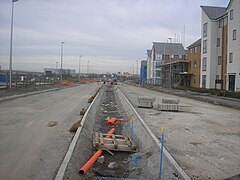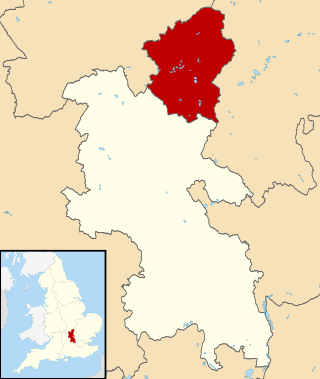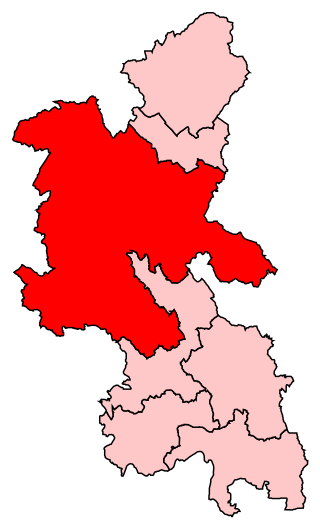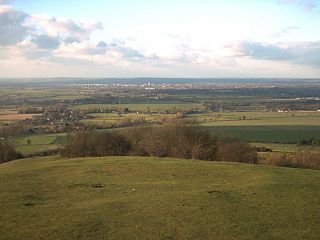Milton Keynes Partnership's strategy
MKP's strategy until 2031 is set out in their "A Strategy for Growth to 2031" document. [5] Their model for the next phase of expansion moves away from grid squares to large-scale, mixed-use, higher-density development. They hope that this will lead to a greener, more sustainable Milton Keynes, less dependent upon the private car. Their aim is to encourage a shift towards alternative transportation such as buses and cycling as well as providing a more pedestrian-friendly environment, particularly within Central Milton Keynes ("CMK"). The strategy does not explain how high density development on the east and west flank expansion areas furthers this objective. The draft strategy proposes that "of the outstanding 34,600 new houses to be accommodated up to 2031, between 11,000 and 14,000 will be located within the existing urban area and the remaining 20,600 to 23,600 through peripheral growth of the city."
Central Milton Keynes
The most significant areas for urban intensification are in Central Milton Keynes ("CMK") and at the northern and southern edges of Campbell Park (see below). Within CMK, development will intensify the existing provision, the most significant being a mixed-use office and retail development known as "The Hub:MK" (originally, "CBX III"). Other proposals for CMK will see the removal and building upon the somewhat profligate surface car parks – particularly along Avebury Boulevard. These will be replaced by multi-storey car parking, releasing the land for better use. Their Hub:MK development is intended to rectify this with buildings of between 8 and 14 storeys in height. These stand out from existing development, which in general is around 4-storey. Other taller structures are being built in the central grid squares, including a new 8-storey building in the Theatre District and a 9-storey building partially housing a new Sainsbury's store. In April 2022 a new 20-storey building, containing a new hotel, Hotel La Tour, with a rooftop restaurant, opened overlooking MK:Centre to the west and Campbell Park to the east.
Campbell Park
In Campbell Park, the intent is to create "a vibrant 24-hour community to bring life into the centre". Development will consist, they say, of high quality apartments with live / work spaces. A series of 'green fingers' or 'wildlife corridors' will be created running out from the park in the centre to the neighbouring areas of Conniburrow to the north and Springfield to the south. These corridors are intended not only to allow wildlife movement throughout the park but to encourage people from other areas to come and use it. The strategy proposes a density of 100 dwellings per hectare, primarily for one or two person households. Additionally, a marina on the Grand Union Canal is planned for the east of the grid square, near the junction with the proposed Bedford Arm of the canal. These areas will be built up as town houses and 3-5-storey apartments.
East and west flanks

In the shorter term, MKP have created development briefs for the East and West flanks that call for high density development well away from the centre, without any grid roads (although featuring 'city streets' which serve a similar purpose but do not follow the grid pattern and lack the green spaces on either side). The areas will have restricted parking facilities – expecting instead that the population will rely on public transport. The target density here is 35 dwellings per hectare. The larger of these begins south of Stony Stratford in the parish of Calverton and is an area the size of three grid squares (about 3 km²) but without any grid roads. This area has been named 'Fairfield'. In his ruling that this development be near Stony Stratford rather than near Whaddon, the Planning Enquiry Inspector remarked that expansion towards Whaddon is inevitable in future developments (beyond the timescale of the plan) unless further expansion crosses the M1. In his view, the M1 need not be considered a barrier to development – though this is contrary to the view of the present Borough Council administration.
On the eastern flank, the first area to be built on will be 'Broughton Gate' (bounded by Broughton, Kingston and the A5130). This will include an extension to the H7 Chaffron Way grid road as far as the A5130, but will not go further and join the Salford Road (with its M1 crossing), thus impeding any further expansion east of the M1. [6] (The plan actually proposes that Salford Road be downgraded to a Redway, closing it to other traffic. A second M1 crossing, Broughton Grounds Lane, is ignored completely – though in the planning application for the enabling infrastructure, the existence of the lane has been reinstated. [7] ) After this the area to the east of the A5130 as far as the M1 motorway and bounded on the south by the A421 will be developed in parts as a residential and industrial estate. The H7 will again extend east through this area, as a city street, turning south upon meeting another city street and meeting the A421. Along the A421 a new employment complex named 'Nova' is planned. Whilst acknowledging the benefit of the grid system, the plan explicitly rules out any role for the former A5130 as a V12 grid route and the development map shows that HGVs will not be permitted to use it. [8]
Further expansion is proposed for the south-east and south-west flanks - see (below)
On 19 November 2009 the MK Citizen reported that it was now likely that the Western Expansion Area would be built with grid roads. The article stated that the H2, H3 and V2 may be extended into the development, to be confirmed by Gallagher Estates' planning application. This follows six months of negotiations on the subject between Gallagher and Milton Keynes Council.
Oakgrove Millennium Community
At Oakgrove (near Middleton), they proposed [9] initially to divert and funnel the V10 Brickhill Street through the heart of the new community and build over the space vacated, including the green routes on either side of it.
Oakgrove is planned to be a completely different style of estate featuring new traffic calming measures, a wildlife corridor and high-density housing, constructed as part of the national Millennium Communities Programme. [10]
On 28 February 2007 the MK News newspaper reported that the V10 diversion plan had been withdrawn. The Citizen confirmed this the following day. English Partnerships have reportedly stated that they respect the importance of the grid system to the population of Milton Keynes. However, [then] Council Leader Isobel McCall stated at the time that she continued to support the "City Street" concept, saying that there was no formal opposition to the concept when first proposed (without saying when any opportunity to do so ever arose). [11]
South-east and south-west expansion
The Draft Strategy proposes (at 13.10)
- Growth Area 1 (South East)
The South-eastern Growth Area consists of approximately 385 hectares (951 acres) of land, and is a triangular parcel of land extending from the existing built up area of Milton Keynes around Wavendon east towards the M1 motorway. This parcel of land is bounded by the A421 to the north, the M1 to the east and the Marston Vale Line to the south. "Access to this area will be made by extending the H10 Bletcham Way". The report goes on to say (13.31, .32) that the development will sweep around Woburn Sands and Aspley Guise without coalescing with them, but that Wavendon will be assimilated. This area is currently being considered as a 'reserve', and greater priority has been given to the Linford Park (northern), Fairfield (western) and Broughton Gate/Nova (eastern) expansion sites mentioned above.
- Growth Area 2 and 3 (South West) – and Salden Chase
The South-western Growth Area proposal was for approximately 875 hectares (2,161 acres) and was to be bounded at its north-east by the southwest point of the existing built up area (West Bletchley) and at its East by the brickfields and landfill site to the south of Bletchley. The area was to be enclosed to the north by the A421 (running east to west across Milton Keynes) and at the south by the road running southwest from Water Eaton to Drayton Parslow. This would have absorbed and expanded Newton Longville in a similar way to the other villages that predate the new city. However, the [HMG] Planning Inspector struck out this proposal, saying that any expansion should be constrained to the south by the disused Bletchley-Bicester railway line.
The more recent Aylesbury Vale Local Development Framework (2009) [12] proposes a more limited version of this vision. The Council proposes (and MKP agrees) to zone land between the railway line and present A421 for 5,360 dwellings, called Salden Chase. [13] The plan explicitly excludes Newton Longville itself from the expansion area. The plan also includes land reservation for a new Newton Longville railway station and for a new link road between the A421 and the A4146 bypassing Newton Longville to the northwest.
Northern expansion
There are two sites to the north of the city that were designated as expansion areas in the 2004 plans. The first is named 'Redhouse Park' and is a residential and industrial district located north of Giffard Park near the M1 Motorway service station. The other area was initially called 'Stantonbury Park Farm' (now called Oakridge Park) and consists of a small residential development north east of New Bradwell. Construction on both these sites is complete.
In 2016, developer Gallagher Estates proposed a substantial further expansion northwards between the railway line and the M1 at Haversham, north of the River Great Ouse. [14] In the February 2017 draft of the Council's "Local Plan to 2031" ("Plan:MK"), the location is no longer shown as a potential strategic expansion area. [15]
Urban intensification
MKP believes that the settlements along Saxon Street (V7) are insufficiently dense to support a sustainable public transport strategy. In a leaked [16] report, [17] MKP appears to be proposing demolition and rebuilding up to six districts at higher population density. The report acknowledges that "Milton Keynes is a planned city and therefore does not contain the obvious degraded and run-down districts that many of our cities possess: areas which clearly lend themselves to policy interventions, aimed at securing urban regeneration and tackling social exclusion." Nevertheless, it does correctly identify some early building that will not last another 25 years. "6.4 Much of the housing within this area was built using innovative construction methods and materials such that many are likely to be nearing the end of their structural life well before 2031, despite some renovation and improvement work that has taken place in certain areas. The declining housing standards are reflected in the findings of the city’s Social Atlas that shows the highest levels of social deprivation are found within these areas." The target density here is 40 dwellings per hectare.
Responding, [18] MKP's chairman Sir Bob Reid denied that any such decision had been taken.










